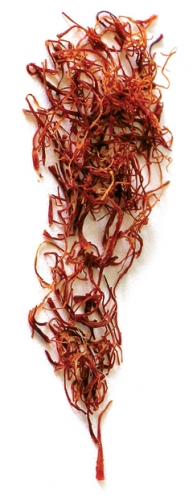
If you’ve ever been to an elaborate Tibetan ceremony—a drupchen, a wedding, a New Year’s party (Losar)— you know these events usually involve hours upon hours of sitting, either on a cushion or against a wall, until your legs go numb. There might be some singing. It might sound like cats in heat. But there is usually a payoff at the end. I mean, of course, in addition to the blessings and all that. Something tangible and delicious. Just when you think your knee joints are about to explode and your head is bobbing from fatigue, a monk or a nun will appear offering a small bowl of golden dretsi (also known as dresil, desi, and dreysi).
Even though Tibetan and Bhutanese households reserve this sweet saffron rice dish for sacred happenings, I like to make it on a Wednesday night when I’m in need of some serious comfort food. Maybe it’s because I’m usually in unusual circumstances when I am served dretsi that I feel festive whenever I make it at home. Anyway, treating myself could be construed as some sort of sacred act too, no? Honoring my inner something or other?
The recipe is rather simple; there is a bit of methodology to be aware of, but the main trick is to select the ingredients carefully. Since there are only five ingredients, it shouldn’t take long to master. But it’s also quite possible for things to go awry and result in a big vat of greasy, sticky, cold, tasteless goo. So I like to take a moment before I start to make sure I’ve got a grasp on my sanity, however feeble. For this I reach for Sharon Crayton’s lovely cookbook One Taste, a mainstay for any contemplative kitchen. Each of her recipes comes with a meditation. Let’s borrow this one: “Stand straight, breathe normally, and watch your in-and-out breath for thirty seconds.” And then we begin. Set aside a few strands of saffron for a garnish later. Bring the water and rice to a boil with the remaining saffron (whole, uncrushed), then cover and cook on medium low heat for seven to ten minutes, until you can easily bisect a grain with your fingernail. Then drain excess water, leaving only enough to keep the rice moist. Place back on the stove and add the rest of the ingredients. There’s no need to stir, just pile them on top. Cook for about three to five minutes at low heat. Turn off and mix with a big spoon. Cook for another three to five minutes and let sit for about five minutes. Serve very hot.
This recipe can be adapted to make more substantial meals as well. You can skip the sugar and add chicken, currents, cardamom, and other spices to make a kind of biryani. Or you can turn it into a rice pudding by increasing the sugar and cooking the rice in milk for a longer amount of time.
The whole thing can go to pot if the rice is too soft. Also, make sure that your nuts are fresh; bad nuts will ruin everything. Some of the worst dretsi I’ve had has been too oily, made with rancid butter, cold, or tasteless.
Saffron is the key ingredient, and though it’s one of the most expensive spices on the market, it’s worth the investment. Sometimes people cheat and use turmeric, which stains the rice a similar golden color, but the subtle, aromatic taste will be completely lost. Saffron is so expensive because a single ounce requires about fourteen hundred stigma of the pale purple Crocus sativus flower, a member of the iris family. One flower contains only three stigma. Thus an acre of land produces only a few vials of saffron. It has been prized for millennia, its first reference in a seventhcentury BCE botanical reference guide. In Chinese medicine, it is used to heal fevers, melancholia, and enlargement of the liver and spleen. In Ayurveda, it is prescribed to cure arthritis, impotence, and infertility.
In the West, we like saffron in paella, but it costs a pretty penny: the average retail price is about $1,000 per pound. Baby Brand is a good company from Kashmir that sells one gram for about fourteen dollars. Less expensive brands can be found, but be wary of products that might be cut with the yellow stamen from male flowers, which do not have the lovely taste of the female stigma. A good quality batch will have long threads with a juicy maroon color, elasticity, and a succulent fragrance. The best on the market come from Iran, Greece, Kashmir, and Spain.
But not from Tibet. There is no Crocus sativus in Tibet. It has to be carted there. Saffron’s presence in a Himalayan ceremony hints at the rich history of Buddhism in the region, though the details are vague. None of the lamas I asked seemed to know when dretsi became part of Tibetan Buddhist ritual. But it must have come from their Arab neighbors. The name saffron comes from the Arabic zafaran, “yellow.” The first Tibetan to lay eyes on the brilliant golden color must have been so pleased. When was that, I wonder? And who? I wonder about wanderers on the Silk Road, trading brocades and betel nut, exchanging ideas and language— Mesopotamians and Bons, Xi’ans and Romans. Those were spicy times.
Ingredients
1 cup white rice (preferably a short-grain basmati, something not too tough)
3 cups water
1 Tbs. saffron
7 ounces golden raisins
7 ounces raw, unsalted cashew nuts
3 Tbs. unsalted butter or very fine ghee
3–4 Tbs. brown sugar